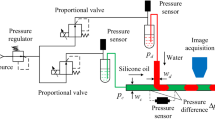Abstract
Producing accurate pulsatile flow rates is essential for many in vitro experimental studies in biofluid dynamics research. A controller system was developed to control a flow loop to produce easily adjustable pulsatile flow rates with sufficient accuracy. An Arduino board is used as a micro-controller to control a pump to produce various pulsatile flow rates, and an open-source proportional-integral-derivative (PID) control algorithm is developed for this purpose. Four non-trivial pulsatile waveforms were produced by the PID controller, as well as an iterative controller, and the performance of both controllers was evaluated. Both the PID and iterative controllers were able to successfully produce slowly-varying signals (single and multi-harmonic low frequency sine waves), but for high frequency signals where the flow has strong acceleration/deceleration (e.g. for physiological waveforms) the iterative controller exhibited significant undershoot. The comparison of PID and iterative controllers suggests that if the desired flow rate is a low frequency, simple waveform then the iterative controller is preferred due to simplicity of implementation. However, if the desired signal is rapidly changing and more complicated then the PID controller achieves better results. This system can be implemented in many flow loops due to its simplicity and low cost, and does not require a mathematical model of the system.



Similar content being viewed by others
Notes
This test section is mainly being used for particle image velocimetry experiments [6].
Due to limitations of the Arduino board SRAM memory the array usually cannot have more than about 1500 elements in it, or it should be stored in the program memory
References
Chaudhury RA, Atlasman V, Pathangey G, Pracht N, Adrian RJ, Frakes DH. A high performance pulsatile pump for aortic flow experiments in 3-dimensional models. Cardiovasc Eng Technol. 2016;7(2):148.
Plewes DB, Urchuk SN, Kim S, Soutar I. An MR compatible flow simulator for intravascular pressure simulation. Med Phys. 1995;22(7):1111.
Tsai W, Sava Ö. Flow pumping system for physiological waveforms. Med Biol Eng Comput. 2010;48(2):197.
Chodzyński KJ, Boudjeltia KZ, Lalmand J, Aminian A, Vanhamme L, de Sousa DR, Gremmo S, Bricteux L, Renotte C, Courbebaisse G. An in vitro test bench reproducing coronary blood flow signals. Biomed Eng Online. 2015;14(1):77.
Liou TM, Li YC. Effects of stent porosity on hemodynamics in a sidewall aneurysm model. J Biomech. 2008;41(6):1174.
Najjari MR, Plesniak MW. Evolution of vortical structures in a curved artery model with non-Newtonian blood-analog fluid under pulsatile inflow conditions. Exp Fluids. 2016;57(6):1–16.
Najjari MR, Plesniak MW. Pump controller program to produce Pulsatile flow rate. 2017;. doi:10.5281/zenodo.821599. https://github.com/mrnajjari/Pump-PID-Controller-Pulsatile-flow.
Holdsworth DW, Norley CJ, Frayne R, Steinman DA, Rutt BK. Characterization of common carotid artery blood-flow waveforms in normal human subjects. Physiol Meas. 1999;20:219.
Acknowledgements
This study was supported by the George Washington University Center for Biomimetics and Bioinspired Engineering. The authors would also like to thank Mahdis Bisheban and Kanishke Gamagedara for their contributions.
Author information
Authors and Affiliations
Corresponding author
Ethics declarations
Conflict of interest
All the authors declare that they have no conflict of interest in relation to the work in this article.
Ethical approval
This study meets ethical standards for engineering studies at the George Washington University. No humans or animals were involved in this study, thus no ethical or IRB review is required.
Rights and permissions
About this article
Cite this article
Najjari, M.R., Plesniak, M.W. PID controller design to generate pulsatile flow rate for in vitro experimental studies of physiological flows. Biomed. Eng. Lett. 7, 339–344 (2017). https://doi.org/10.1007/s13534-017-0049-9
Received:
Revised:
Accepted:
Published:
Issue Date:
DOI: https://doi.org/10.1007/s13534-017-0049-9




